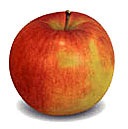Apples… the most popular fruit in the US. Americans eat about 16 pounds of apples and drink more than 2 gallons of apple juice per person every year.
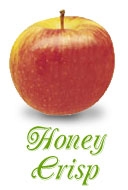
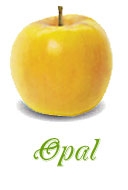
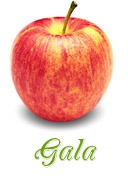
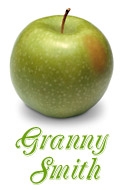
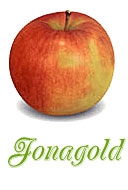
Walk into any supermarket and what do you find? Bins of shiny red, yellow, and green apples. What seems like an abundance of apples is an illusion. Just 11 varieties of apples make up 90% of those grown, sold, and eaten in the US. What’s more, 40-plus percent of apples sold are only one variety: Red Delicious.
The apple industry has succumbed to the same consolidation and specialization affecting the rest of the food industry. As a result, the number of apple varieties has plummeted. Just 100 years ago, as Slow Food USA estimates, there were more than 15,000 varieties of apples unique to North America. Only about 2,500 varieties are raised in the US today and most Americans are likely to have tried only handful.
The US Department of Agriculture tracks just 22 individual apple varieties and lumps the rest into an “Other” category:
| Red Delicious | Cripps Pink | Stayman |
| Gala | Braeburn | Newton |
| Golden Delicious | Idared | R.I. Greening |
| Granny Smith | York | Northern Spy |
| Fuji | Jonathan | Winesap |
| McIntosh | Cortland | Gravenstein |
| Rome | Jonagold | |
| Empire | Cameo |
Even with the consolidation and long distance shipping of fruit, apple preferences are regional and the apples popular on the East Coast vary from those on the West Coast. Depending on your region you may find a different variety in the local supermarket. In Puget Sound, you can buy varieties like Ginger Gold, Opal and Pink Lady. In Michigan there are Cortland and McIntosh, and Gala, Idared, Crispi, and Empire are on the list in New York.
Why the decline in varieties?
(Click on any image below to see a larger version.)
The decline in apple varieties has been influenced by changes in purchasing patterns, business operations, land use policies, and weather patterns.
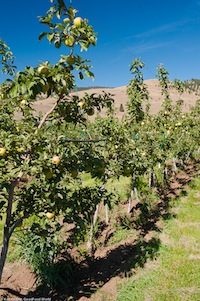
Buyer preference: Consumer tastes are changing, including a preference for bright and consistent color. And flavor choices fall in and out of fashion, with Honeycrisp (a variety developed and patented by the University of Minnesota) growing in popularity. Honeycrisp is an attractive, excellent eating apple, very juicy with a sweet/tart flavor.
Industry operational efficiencies: Large grocery chains and big box stores look for consistency, “shelf life,” and shipping resilience. Large packers want apples that store well to extend the shipping season. Rather than breeding for taste, apple breeders are looking for apples that travel and store well; any apple that doesn’t keep or transport well is automatically out of consideration.
Changing import and export patterns: The US is a major exporter of fresh apples, shipping more than 1.8 billion pounds. As the key apple-producing state, Washington exports a large amount of fresh apples to China and Hong Kong. More than 2.5 million boxes (about 105 million pounds) of apples were shipped from the 2011 crop to just these two locations.
At the same time, in 2011, the US imported about 325 million pounds of fresh apples and 502 million gallons of apple juice. Chile was the leading supplier of fresh apples, though 73 million pounds came from New Zealand (down 21% from the previous year). China, Argentina, Chili, and Brazil are the top sources of apple juice. According to the USDA Foreign Agricultural Service, about 60% of domestic apple juice consumed is sourced from China.
Like many other food products in the world market, apples move both ways in the distribution system, no longer depending on close proximity to the consumer but on global customers willing to pay a higher price and on low energy costs for transportation.
Changing land use: Suburban sprawl has turned many acres of cropland, including orchards, into subdivisions. And apple production has moved from Midwestern states like Minnesota, Wisconsin, and Michigan to Washington. While the actual number of “apple acres” has decreased about 32 percent over the last 30 years, the acreage in Minnesota, Wisconsin, and Michigan has shrunk more than 35 percent to fewer that 54,000 acres.
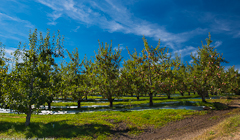
Apple production in Washington has been a “boom and bust” industry over the last 30 years, with the number of apple orchards dropping through consolidation and attrition by nearly 45 percent between 1982 and 2007. The state – which produces about 60 percent of the apple crop in the US – has seen a rollercoaster growth and decline in total apple acres over the same period.
In 1982, the USDA reported that Washington had 145,000 apple acres, which grew to 215,000 acres by 1997. The number of apple acres has since dropped to about 165,000, a decline of nearly one quarter from the peak. The state’s production for the 2012 season is expected to be 840 million pounds, down from last year’s record 914 million pounds, a drop of about 8 percent.
While the number of apple acres has declined – primarily from the incorporation of smaller more productive trees set closer together – actual production per acre continues to climb. Annual fluctuations because of weather and labor availability have a larger effect on the actual production numbers than the number of acres.
Changing weather patterns: As weather patterns change and temperatures in fruit growing areas rise, the number of “winter chill hours” is going down. Not good for skiers and fruit growers!
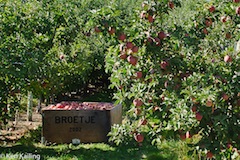
Fruit trees develop the next year’s buds during the summer and fall, and then the trees go dormant for the winter. A healthy dormancy is triggered by a certain minimum exposure to chilling temperatures. Lack of such exposure results in delayed and substandard foliation (leaf growth), flowering and fruiting.
The simplest definition of “chill hours” is that one unit is equal to one hour’s exposure to chilling temperatures; the hours are then totaled for the season. Apples have the highest chilling requirements of all fruit trees and most apple varieties require 1,000 chill hours to yield harvests large enough to be economically viable.
This year, Michigan, traditionally the third largest producer of fresh apples after New York, had a particularly devastating year of “whacky spring weather” that followed a rare warm March with below-freezing nights in April. A harvest of about 3 million bushels is forecast, down from the usual 23 million.
The long drought in the Midwest has been devastating to corn and soybean farmers, but hasn’t been considered a leading cause of the apple crop decrease this year because apple trees have deep roots suited to reaching groundwater, according to the Michigan Apple Committee. Should the drought continue though, the groundwater level may drop further and affect fruit trees in the coming years.
Organic Alternatives
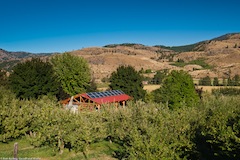
In 1989, consumer health concerns about chemical use in food production reached a high when media coverage focused on the use of Alar – a growth regulator used in apple production. Long term-exposure posed significant health risks and manufacturers halted sales and distribution for food uses. Apple production across the country took a hit, and growers began to experiment with low-chemical or pesticide-free fruit production. Although the use of pesticides has declined in conventional orchards, still more than 80% of conventional apple acres are treated with pesticide.
Today’s consumers are smarter, more careful, and more particular about the food they buy, and they often choose organic options. Sales of organic produce continue to show double-digit growth, even during the recent economic downturn, and fresh produce is the largest category of organic food sales. Apples are one of the top three fresh fruits purchased by consumers of organic foods.
While the price premium for organic apples has decreased slightly with the growth in supply, there is still a small economic benefit to growing organic fruit. Organic apple production is more labor intensive than conventional productions, which means labor costs are higher. On the other hand there are fewer inputs – fertilizers, pesticides, antibiotics – used to grow organic fruit.
Hot summers, cold winters, and irrigation make it possible for Washington to grow 65% of the nation’s organic apples. The dry climate in the central and eastern portions of the state is especially suited for growing apples, and even more advantageous for organic production. Organic pest management is much more challenging in the more humid eastern US where pests and disease are more prevalent.
Certified organic acreage for apple production – now about 10% of the state’s apple acreage – is around a little more than 14,000 certified and transitional acres. Gala and Fuji make up 45% of the total, while less than 10% are Red Delicious. Honeycrisp is the fastest growing variety, with organic acreage increasing from just 157 acres in 2003 to 1,099 acres in 2010.
Labor Challenges
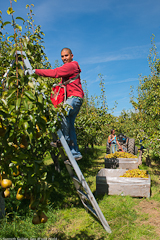
Apple picking used to be summer work for college kids, housewives, and retirees. It was hard but work with a lot of camaraderie. There would be kids, pets, and picnic lunches in the orchards.
Anybody can pick apples, right? You just take them off the tree and put them in a bag… Wrong! Picking apples is considered skilled labor and it’s hard work. Today’s apple picker has to be in shape. Climbing 10 to 12-foot ladders and handling picking bags that can weigh up to 60 pounds for 9 hours a day, 6 days a week, is not child’s play.
The camaraderie is a thing of the past: modern food and worker safety laws restrict the presence of anyone not on the work crew, meals in the orchards, and – certainly – any animals!
Pruning, thinning and harvesting are all performed manually and require highly skilled laborers; and they are all done during the growing season, so growers depend on reliable crews of seasonal workers.
Apple growers face an especially challenging season this year. Michigan growers have so few apples that they can’t keep the small number workers in the fields busy. Midwestern seasonal workers are leaving the state to work in other orchards.
Washington growers, on the other hand, are facing continued shortages of workers and are likely to leave fruit on the trees at the end of the season. A majority of farm workers – including fruit pickers – are Hispanic or people of color, many them immigrants and some of whom are undocumented workers.
In Western Washington there are few people looking for farm work, a situation that has growers blaming immigration policies. There are other factors that also may be affecting the availability of workers including improvements in the Mexican economy and more education opportunities in Mexico.
US workers are either unskilled, unwilling to take the work for the wages offered, or find the work too hard. Experienced workers can make $120 to $160 a day picking apples, but that’s a lot of apples! Each bin picked brings in about $20 – around a penny an apple! It takes about 26 full picking bags of approximately 75 apples each to fill a bin.
Meet the Producers
Most of the US apple harvest is transported to warehouses for grading, packing, and storage before being sold into markets as fresh apples. While there are large-scale, integrated grower/packer/shipper operations with hundreds – and sometimes thousands – of acres of organic apple trees, apples continue to be an important crop for many smaller farms west of the Cascades.
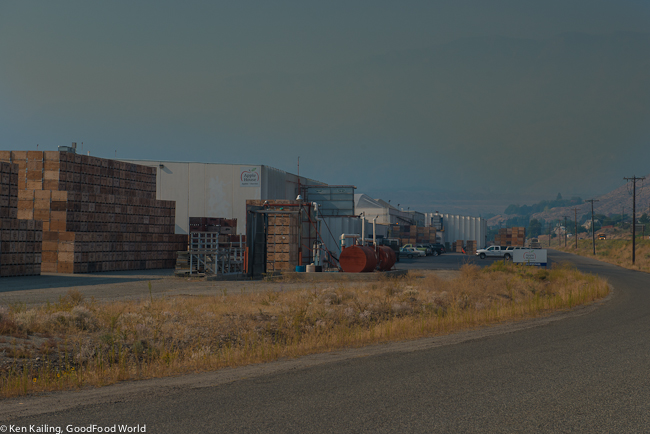
Because small and medium-sized growers generally work with packing companies to process, store and market their fruit, a continuous chain of certified handlers must be in place to maintain an “audit trail” through the supply chain. That is possible because more than 25 percent of the state’s apple packers hold Organic Handler Certificates from the Washington State Department of Agriculture’s Organic Food Program.
Broetje Orchards: The Big Guys With a Heart
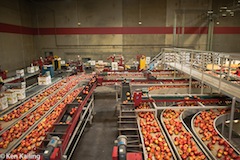
Ralph Broetje, founder/owner of Broetje Orchards, Prescott WA, is a modest man who clearly does not consider himself a latter-day reformer, but he is working to improve conditions for both thepermanent and seasonal workers in his employ.
Founded in the late 1970s, the present day orchard generates sales of more than $80 million from approximately 5000 acres of conventionally grown apples and about 1000 acres of organic apples. More than 2,500 workers harvest those apples and nearly 1000 work year round to keep the orchard – and the staff – healthy and productive.
Read more about Broetje Orchards here.
River Valley Organics: Good Apple Karma
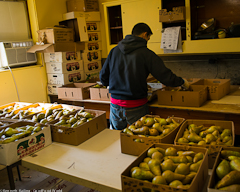
Take a drive north on Highway 97 and you will pass along the Columbia and Okanogan Rivers between tiers and tiers of orchards growing all kinds of fruit, from stone fruit – apricots, nectarines, and peaches – to apples, pears, and cherries, and the occasional quince. Just a few miles north of Tonasket WA you’ll find River Valley Organics.
What’s is it that makes River Valley Organics so special? It couldn’t be size, since the entire orchard is only 18 acres (3 acres of cherries and 15 of pears and apples).
It couldn’t be the varieties of plants, after all, Lapin cherries, Gala, Fuji, Honeycrisp and Cameo apples, and Bosc pears grow throughout central and north central Washington.
River Valley Organics is special because of a unique combination of karma and heart.
Read more about River Valley Organics here.
Small Family Orchards: Nimble and Creative
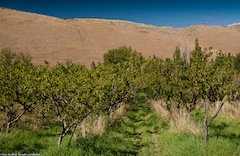
Growing fruit on as few as five acres are four small family orchards located in north central Washington: Booth Canyon Orchard, Pipitone Farms, Sinclair Orchard, and the orchard in which the Methow Valley Ciderhouse sits.
On small farms of 15 acres or less, these orchardists must be especially creative to compete with large industrial operations – both commercial and organic. Each one of these families has chosen a different “value add” in which to specialize, in order to support the extra care they take and the higher prices they need to charge for their products.
Read more about these family orchards here.
Photo credit: Apple line up – First Fruits/Broetje Orchards
______________________
All About Apples – Additional Reading:
Apple Varieties Disappear From US Markets
What’s Driving Our Favorite Fruit Into Decline?
Forgotten Fruits Manual and Manifesto – Apples (Pdf)
Chilling Requirements for Tree Fruit
New Zealand Fresh Apple and Pear Production and Trade – May 2012 (Pdf)
Great Lakes Apple Harvest Off to an Early Start
Northwest won’t set record but growers expect big crop returns
Exceptional New Zealand Organic Apple Season
Apple Growers Face Near Record Harvest and Worker Shortage
Skilled apple pickers needed to avert disaster
Washington Apples – The Best Organic Apples on Earth®
USDA ERS Characteristics of Conventional and Organic Apple Production in the United States (Pdf)

